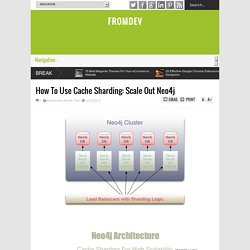

Setting Up Neo4j 2.0 on an Ubuntu Server — delimited. Authored by Steven Hall Neo4j 2.0 is an awesome release of Neo Technology's great graph database.

There are some significant new features and some changes to the data model that, I think, make it more accessible. You can install it locally to play around and do some testing, but I wanted to create a remote server that I could use as a back-end for data visualization projects. Below are some notes on getting Neo4j installed on Ubuntu 12.04. There are some real gotchas that took some time to figure out, but if you follow this step-by-step procedure you should have the browser application bundled with Neo4j up and running in less than 15 minutes. I should note that the Neo4j website has instructions for setting up on debian based systems, but those instructions, which are very helpful, are incomplete and in some cases just don't work for Ubuntu 12.04 (at least at the time I am writing this post).
Start from Fresh Ubuntu 12.04 Install Install Java 7. Chapter 23. High Availability - - The Neo4j Manual v2.1.6. Other Neo4j Releases. 23.6. High Availability setup tutorial - - The Neo4j Manual v2.1.6. How To Use Cache Sharding: Scale Out Neo4j. Neo4j is a high availability graph database that support ACID properties for transactions.

As per the CAP theorem, any system can provide only two of the properties from Consistency, Availability and Partition tolerance. Just like relational databases, Neo4j has also chosen the Consistency and Availability options. Consistency in Neo4j is guaranteed by supporting ACID properties to transaction. Availability is achieved using high availability clustering that is supported by a master slave architecture with one master for all write operations and many slaves for read operations. The architecture of Neo4j is fairly scalable, however it can only scale UP. In case you are looking for a scaling OUT option you may need to use your own technique to make best use of Neo4j resources.
In fact, this technique of cache sharding is not really new to Neo4j. What Is Sharding? Sharding is a technique to horizontally partition your data. Sharding implementations are complex. What Is Cache Sharding? Summary.
LOAD CSV into Neo4j quickly and successfully. Posted by Michael Hunger on Jun 25, 2014 in cypher, import | Since version 2.1 Neo4j provides out-of-the box support for CSV ingestion.

The LOAD CSV command that was added to the Cypher Query language is a versatile and powerful ETL tool. It allows you to ingest CSV data from any URL into a friendly parameter stream for your simple or complex graph update operation, that … conversion. But hear my words of advice before you jump directly into using it. There are some tweaks and configuration aspects that you should know to be successful on the first run. Data volume: LOAD CSV was built to support around 1M rows per import, it still works with 10M rows but you have to wait a bit, at 100M it’ll try your patience.
The CSV used in this example is pretty basic, but enough to show some issues and make a point, it’s people and companies they work(ed) for. GraphAcademy - Neo4j Graph Database. The Neo4j Manual v2.1.6 - Import Data Into Neo4j - Neo4j Graph Database. Neo4j, the World's Leading Graph Database. Network Visualization. Graph-database. Graph DB. Graph Stuff. NoSQL. Naturallanguageprocessing. Graph. Graph DBs. Rdf-neo4j.
Graph Processing With Apache Pig. On Importing Data into Neo4j (Blog Series) Posted by Michael Hunger on May 25, 2013 in development, neo4j | Being able to run interesting queries against a graph database like Neo4j requires the data to be in there in the first place.

As many users have questions in this area, I thought a series on importing data into Neo4j would be helpful to get started. This series covers both importing small and moderate data volumes for examples and demonstrations, but also large scale data ingestion. For operations where massive amounts of data flow in or out of a Neo4j database, the interaction with the available APIs should be more considerate than with your usual, ad-hoc, local graph queries.
This blog series will discuss several ways of importing data into Neo4j and the considerations you should make when choosing one or the other. Basically Neo4j offers several APIs to import data. Conceptual Discussion Neo4j is a fully transactional, ACID database which includes durability guarantees. (Actor)-[:ACTED_IN]->(Movie)<-[:RATED]-(User)